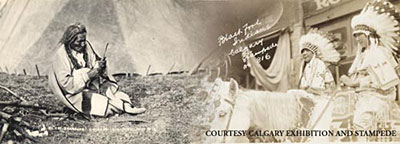|
The attendance of more than eighteen hundred Indians at the Stampede was a credit to Guy Weadick’s persistence and political acumen. At the time, the federal government was opposed to Indians leaving their reserves to take part in fairs or rodeos. Their concern was three fold: that once Indians left their farms they would be reluctant to return; that they would be exposed to immoral influences at the fairs; and that by dressing in their costumes and performing dances, they would be reinforcing a part of their culture that the government wanted them to forget.
When his initial request to permit Indians to go to the Stampede was refused, Guy Weadick had turned to two influential Calgarians, Sir James Lougheed and R.B. Bennett, later Prime Minister of Canada. In short order, they had the minister of Indian Affairs ordering his staff to co-operate with the Stampede and to encourage the local Indians to attend.

Chief Inspector Glen Campbell was placed in charge of the recruitment effort, and he toured each reserve to gain the co-operation of reluctant Indian Agents. Indian scouts were engaged to be in Calgary to patrol the camps; Chiefs and Council were invited to meet the Governor General; and Indians were told they could take part in the parades, sign up for the rodeo events, or simply go as spectators.
Indians flocked to Calgary by the hundreds for the big event. Dozens of men and women brought their finest costumes and horse gear for the parades and put on a spectacular show. The Toronto Globe commented that, “gorgeous display of paint, beads and colored blankets was made by the 6 tribes of Indians who formed the bulk of the parade, and leant a historic picturesqueness to the modern city street with its thousands of thronging spectators.
Indians were everywhere. They offered daily dances, joined in parades, and signed up for the Indian Races. Among the relay racers War Chief and Duncan McMaster, William Soldier and Tom Spotted Bull. Pony racers included Philip Big Swan, Joe Three Sons, Tom Spotted Bull, Black Eagle, Tom Weasle Horn. In the bareback wild horse race where Bad Eagle, Big Chief, and a Stoney named David. Although a number of Indians took part in the races, Tom Three Persons was the only native contender in any of the four top rated events- bucking horse, bareback, steer roping, and bulldogging.
Excerpt taken from: Dempsey, H. (1997). Tom Three Persons: Legend of an Indian cowboy. Saskatoon, Saskatchewan: Purich Publishing. |





